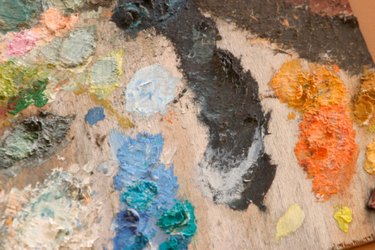
An American impressionist in Paris, Mary Cassatt distinguished herself, in a genre dominated by French men, with a body of work that centered around the domestic life of women and children. Defying both the expectations of a 19th-century upbringing and her father, Cassatt studied at the Pennsylvania Academy of Art before traveling to France to display her work alongside greats such as Claude Monet and Edgar Degas. Adventurous both in character and artistic medium, Cassatt continued to challenge herself by experimenting with many different materials, from oils on canvas to watercolors, pastels and printmaking.
Oil on Canvas
Video of the Day
Many of Cassatt's paintings were created using the most traditional type of painting, oil on canvas. Even though she did use other mediums, Cassatt worked with oil paint over her entire career. "The Mandolin Player," painted early in her career in 1868, is an example of Cassatt's technical skill with the medium and was accepted for display at the Paris Salon, the official art showcase in France. Other examples of Cassatt's work with oil include "Children Playing on the Beach" in 1884, "Mother and Child (The Oval Mirror)" in 1889 and "Denise at her Dressing Table" in 1908.
Video of the Day
Gouache
"Portrait of the Artist," painted in 1878, is an example of Cassatt's use of gouache. An opaque watercolor paint, gouache is made by mixing pigment with a binder, such as gum arabic, a natural gum made from the dried sap of the acacia tree. Painted on wove paper, a type of handmade paper formed with a wire mesh screen or fabric, the self-portrait was one of two painted by Cassatt. Unlike transparent watercolors, gouache allows for more vibrancy in color, as seen in the reds and purples in her bonnet and bow at her neck.
Pastels
In many renderings of mother and child, Cassatt used the easily blended, soft colors of pastels. Related to chalk, pastels are drawing sticks composed of ground pigments held together with water-based binders, such as gum tragacanth, a natural gum made from the dried sap of legumes. In three pastel drawings on wove paper, "Nurse Reading to a Little Girl" in 1895, "Mother Playing with Child" in 1897 and "Mother Feeding Child" in 1898, Cassatt made use of soft pastel tones in blue, green, yellow, and pink to convey the natural beauty of domestic life.
Printmaking
Due to an interest in Japanese art and the influence of Edgar Degas, whom Cassatt greatly admired and who regularly used various forms of printmaking, Cassatt produced many beautiful prints. Using print techniques such as drypoint, aquatint and soft-ground etching, both alone and in combination, Cassatt continued to examine the lives of women and children. Drypoint is the method of engraving directly onto a copper plate with a sharp stylus, while both aquatint and soft-ground etching use acid to create an image on a metal plate. Examples of all three can be seen in "Woman Bathing" in 1890 to 1891 and "Maternal Caress" in 1891.